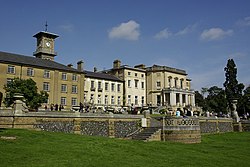| Bentley Priory | |
|---|---|
 The priory in 2008 | |
| Type | Stately home |
| Location | Harrow |
| Coordinates | 51°37′36″N 0°20′03″W / 51.62669°N 0.334175°W |
| OS grid reference | TQ 15473 93279 |
| Area | London |
| Built | 1789–1818 |
| Architect | |
Listed Building – Grade II* | |
| Official name | Central entrance block of Bentley Priory |
| Designated | 25 May 1983 |
| Reference no. | 1358638 |
| Official name | Bentley Priory |
| Designated | 9 December 1999 |
| Reference no. | 1001440 |
Bentley Priory is an eighteenth to nineteenth century stately home and deer park in Stanmore on the northern edge of the Greater London area in the London Borough of Harrow.
It was originally a medieval priory or cell of Augustinian Canons in Harrow Weald, then in Middlesex. There are no remains of the original priory, but it probably stood near Priory House, off Clamp Hill.[1]
In 1775, Sir John Soane designed a large mansion house north of the original priory, called Bentley Priory, for the wealthy businessman James Duberley. This was added to throughout the eighteenth and nineteenth centuries by various owners. It was significantly extended in 1788, again by Sir John Soane, for John Hamilton, 1st Marquess of Abercorn. The priory was the final home of the Dowager Queen Adelaide, queen consort of William IV, before her death there in 1849. It subsequently served as a hotel and girls' school before being acquired by the Royal Air Force in 1926.
In the Second World War, Bentley Priory was the headquarters of RAF Fighter Command, and it remained in RAF hands in various roles until 2008.
As of 2013, the site has been sold to a developer and plans to convert some of the building to luxury apartments and build new houses have been approved and construction commenced. The Bentley Priory Battle of Britain Trust has secured part of the building to be used as a museum and memorial dedicated to those who served in the RAF.
